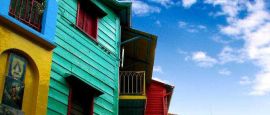Buenos Aires History
Founded in 1536 by Spanish explorer Pedro de Mendoza, Buenos Aires was named after the patron saint of sailors – said to be responsible for the good wind, or buen aire.
After Mendoza’s initial settlement (in what is now the San Telmo neighbourhood) was abandoned, a second and successful attempt to found a city, led by another adventurous Spaniard, Juan de Garay, happened in the late 1500s.
During the 17th and 18th centuries, Buenos Aires grew rapidly, with its port conducting an increasing amount of trade. The British invaded at the start of the 19th century, but failed to capture the city. In 1810 the Argentines campaigned in force to free themselves of Spanish rule; independence was achieved six years later.
Mass immigration to Buenos Aires occurred at the end of the 1800s, as workers were brought in from abroad to service agriculture and the railways. Development ceased in the mid-20th century, as the country’s economy declined – mostly owing to lack of investment from war-torn Europe. Immigrants arrived from other parts of Argentina and were forced to reside in shanty towns – or Villas Miseria as they were aptly described.
One of the most prominent events in Buenos Aires’s history was the election of President Juan Perón, in 1946. Strong socialist roots made him popular amongst the working classes, as did his much-celebrated wife Eva Perón, known as Evita. Anti-Perón forces were notable, and they enlisted Argentina’s own army to bomb Plaza de Mayo in an attempt to dislodge him. Although this ultimately failed, Perón was removed from power twice – the final time, in 1976, and it was followed by a brutal military dictatorship that lasted until 1983.
After defeat in the Falklands War, Argentina returned to democratic government.
In 2001, the country suffered a disastrous economic crash that left Buenos Aires paralysed and desperate, and there were many violent protests in the capital. Today, the city is a much calmer and more stable place.
Did you know?
• The tango dance originated in the brothels of the city in the immigrant ghetto in the late 19th century in what is present day La Boca.
• Avenida 9 de Julio is the widest street in the world and spans a head-spinning 16 lanes.
• The use of finger printing in forensic evidence was first ever used successfully in the world in Buenos Aires to convict a woman who committed a double murder in the late 19th century.
Do you have any Feedback about this page?
© 2025 Columbus Travel Media Ltd. All rights reserved. No part of this site may be reproduced without our written permission, click here for information on Columbus Content Solutions.




 You know where
You know where